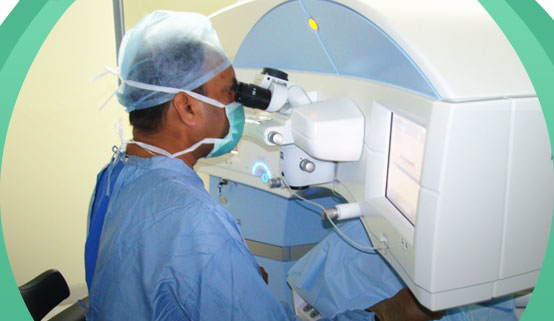|
 |
In Lasik, the excimer laser is used to reshape the cornea
thereby correcting myopia, hyperopia and astigmatism.
We at Dr Virendra Laser,Phaco Surgery Centre uses one
of the most Accurate
excimer laser, the Super Technologies.
The very fact that you are visiting this website means
that you have probably heard enough about laser eye
treatment to arouse your interest. Over the past few
years, laser eye treatment has been seen to make an
enormous difference to people with near-sight, far-sight
and astigmatism. It's a difference that has changed
their quality of life as well as their quality of vision.
Utilizing the accuracy and precision of the excimer
laser, LASIK changes the shape of the cornea to improve
the way light is focused or "refracted" by the eye.
By adjusting the pattern of the laser beam through its
computer, it is possible to treat high levels of nearsightedness,
farsightedness and astigmatism.
LASIK surgery is performed as an outpatient procedure
in the comfort and convenience of the excimer laser
surgical suite. The entire vision correction procedure
takes less than 30 minutes and both eyes are done the
same day. The procedure is performed using topical anesthesia
(eye drops). Some patients report a slight, post-operative
discomfort that can usually be alleviated with medications.
Patients see a dramatic improvement in their vision within the first
day. Most patients return to their normal activities within a day or
two.
|
|
Step by Step
The LASIK procedure takes a few minutes to complete, and the
procedure is relatively painless. Patients are always amazed
at the ease of this procedure because of speed and comfort.
Only topical anesthetic drops are used to numb the eye for the
procedure. An eyelid holder is inserted to prevent blinking
while the drops eliminate the reflex to blink.
 Step
1 Step
1
A suction ring is placed on the eye to secure the eye and maintain
pressure within the eye while the corneal flap is created. A
microkeratome, an automated microsurgical instrument similar
in design to a carpenter's plane, is used to create a thin corneal
flap which remains hinged beneath the upper eyelid.
The corneal flap is 160 to 180 microns thick, about 30% the
corneal thickness which is typically about 550 microns. Patients
do not feel or see the cutting of the corneal flap, which takes
only a few seconds. Corneal "flap making" has been researched
and developed for 40 years, providing us with a long history
of safety and stability.
 Step
2 Step
2
The corneal flap is then laid back and the inner stromal layers
of the cornea lasered with the patient's prescription. An ultraviolet
light from the excimer laser reshapes the internal cornea with
an accuracy of 1/2000th of a milimetre.
For reshaping the cornea, the corneal surface is polished with
the help of a pre-programmed excimer laser. This changes the
refractive power of the cornea thus eliminating the refractive
error of the eye.
 Step
3 Step
3
The corneal flap is then repositioned and the flap and interface rinsed. Once the procedure is completed, the surgeon will wait 2 to 3 minutes to ensure the corneal flap has fully re-adhered.
At this point, patients can blink normally and the corneal
flap remains secured in position by the natural adherence
within the cornea. While it is possible to dislodge the
corneal flap during the first day or two by physically
rubbing the eye, this event is actually quite rare. After
the first week, LASIK patients can resume their full
exercise activities.
Since the protective layer remains intact with LASIK, no
bandage or contact lens is required. However, a protective
eye shield is normally recommended for a day. LASIK patients
are placed on an antibiotic and anti-inflammatory drop
regimen for about 1 week. They also need to instill
artificial tears for a few months. Patients are able to
travel by air immediately and exercise after 1 week.
LASIK is generally considered the method of choice for using
the Excimer Laser for correcting refractive errors. Another
popular technique is Photo Refractive Keratectomy or PRK.
LASIK is generally the method of choice because it allows
faster post-operative recovery of vision, requires less
follow-up, and allows the patient to be more comfortable
faster. However, there are circumstances under which it is
more appropriate to use PRK in some patients. Your New
Vision eye surgeon will advise you appropriately. |
|
|
|
